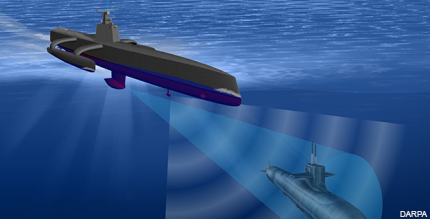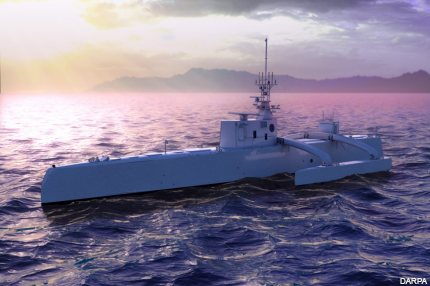Pentagon prepares to test its sub-hunting drone vessel
The ACTUV, developed by DARPA, is set for tests in early 2016 and could see its role expanded to other missions.

An artist’s concept of DARPA’s ACTUV.
One example: the Anti-Submarine Warfare Continuous Trail Unmanned Vessel, or ACTUV, a 132-foot long, 140-ton surface vessel* that is set for tests in early 2016 and which could see its role expanded beyond just countering subs.
ACTUV, being built by Leidos, is the result of a Defense Advanced Research Projects Agency program. The vessel currently is about 90 percent complete, with all of the hardware finished and the remaining software being engineered, according to a release from the Defense Department.

ACTUV would track subs from the surface.
DARPA started the program with three goals established around the idea of tracking submarines. First, the program seeks to explore the limits of unmanned vehicles, hoping for a design that “exceeds state-of-the art platform performance” that could allow ACTUV to trail “diesel electric submarines at a fraction of their size and cost.” Second, the program wants to advance maritime unmanned autonomy by increasing the range and endurance of unmanned littoral vessels while also building in international maritime legal compliance and the ability to interact with intelligent adversaries. And third, the program aims to demonstrate non-conventional sensor technologies capable of achieving robust continuous tracking of quiet submarine targets over an entire operating envelope.
In addition to these robust goals, some officials have suggested an even more expansive mission sets for the ACTUCV program. Scott Littlefield, program manager of DARPA’s Tactical Technology Office, said that the Navy is considering mine countermeasures among various other missions for the vessel.
One big reason is cost. Littlefield said that ACTUV would cost around $15,000 to $20,000 per day to operate, as opposed to the roughly $700,000 it takes to operate a destroyer.
The ACTUV is also capable of greater payload and endurance capability than ship-launched unmanned surface vehicles, it could work from a pier and the Navy wouldn’t have to worry about integrating it with another ship.
Testing for the ACTUV is expected to start in either January or February.
Navy officials have also discussed the need for underwater unmanned systems, referred to as undersea unmanned vehicles, or UUVs. “Thousands of miles of logistical networks [will] allow large scale deployment of UUVs, allowing them to communicate, engage, resupply…those technologies are focused around the same technologies that support our directed energy, our unmanned systems and our electric weapons,” Chief of Naval Research Rear Adm. Mathias Winter said at an event hosted by the Center for Strategic and International Studies in August.
The Navy is gearing up for testing of its Large Displacement Unmanned Undersea Vehicle, or LDUUV, prototype, which the Office of Naval Research said will provide “game-changing capabilities to naval warfighters,” in undersea ISR, acoustic surveillance, anti-submarine warfare, mine counter-measures, and offensive operations.
The military has even sought to converge the air and sea domain with the Navy Research Laboratory’s Flimmer project – an unmanned system that can both fly and dive underwater to improve “tactical availability of UUVs in time critical situations.”
* A previous version of this story incorrectly referred to ACTUV as an underwater vessel.
NEXT STORY: Army developing a power-generating backpack